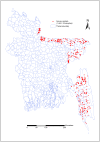Malaria prevalence in endemic districts of Bangladesh
- PMID: 19707580
- PMCID: PMC2726938
- DOI: 10.1371/journal.pone.0006737
Malaria prevalence in endemic districts of Bangladesh
Erratum in
- PLoS One. 2009;4(9). doi: 10.1371/annotation/546e7848-4fcb-49d3-8c63-4010445f21da
Abstract
Background: Following the 1971 ban of DDT in Bangladesh, malaria cases have increased steadily. Malaria persists as a major health problem in the thirteen south-eastern and north-eastern districts of Bangladesh. At present the national malaria control program, largely supported by the Global Fund for AIDS, Tuberculosis and Malaria (GFATM), provides interventions including advocacy at community level, Insecticide Treated Net (ITN) distribution, introduction of Rapid Diagnostic Tests (RDT) and combination therapy with Coartem. It is imperative, therefore, that baseline data on malaria prevalence and other malaria indicators are collected to assess the effectiveness of the interventions and rationalize the prevention and control efforts. The objective of this study was to obtain this baseline on the prevalence of malaria and bed net use in the thirteen malaria endemic districts of Bangladesh.
Methods and principal findings: In 2007, BRAC and ICDDR,B carried out a malaria prevalence survey in thirteen malaria endemic districts of Bangladesh. A multi-stage cluster sampling technique was used and 9750 blood samples were collected. Rapid Diagnostic Tests (RDT) were used for the diagnosis of malaria. The weighted average malaria prevalence in the thirteen endemic districts was 3.97%. In five south-eastern districts weighted average malaria prevalence rate was 6.00% and in the eight north-eastern districts weighted average malaria prevalence rate was (0.40%). The highest malaria prevalence was observed in Khagrachari district. The majority of the cases (90.18%) were P. falciparum infections. Malaria morbidity rates in five south-eastern districts was 2.94%. In eight north-eastern districts, morbidity was 0.07%.
Conclusion and significance: Bangladesh has hypoendemic malaria with P. falciparum the dominant parasite species. The malaria situation in the five north-eastern districts of Bangladesh in particular warrants urgent attention. Detailed maps of the baseline malaria prevalence and summaries of the data collected are provided along with the survey results in full, in a supplemental information.
Conflict of interest statement
Figures




References
-
- Greenwood BM, Boding K, Witty CJM, Target GA. Malaria. Lancet. 2005;365:1487–1498. - PubMed
-
- Benet S, Woods T, Liyanage WM, Smith DL. A simplified general method for cluster-sample surveys of health in developing countries. World Health Statistics Quarterly. 1991;44:98–106. - PubMed
-
- Sharma VP. Re-emergence of malaria in India. Indian Journal of Medical Research. 1996;103:26–45. - PubMed
-
- WHO (World Health Organization). Malaria 1982–1997. Weekly Epidemiological Record. 1999; 74:265–70.
-
- Wijeyaratne PM, Valecha N, Joshi AB, Singh D, Pandey S. Washington DC: USAID, 2004; An inventory on malaria drug resistance in Bangladesh, Bhutan, India and Nepal. Environment Health Project Activity Report 130.
Publication types
MeSH terms
Substances
LinkOut - more resources
Full Text Sources
Medical
Miscellaneous

